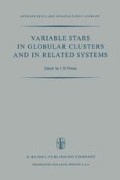Abstract
NGC 6981=M72 is a globular cluster with a late-type integrated spectrum (G3) and an ultraviolet excess of δ(U − B)=0.15±0.05, which places the cluster in the class of intermediate-to-high metal abundance clusters such as M3. The colour-magnitude diagram shows a horizontal branch populated on both sides of the variable star region. Previous work on the periods of the variables has indicated that the cluster is of Oosterhoff type I, with \(\overline {{P_{ab}}} \approx 0.55\) day. Some results from B and V photometry of 21 RR Lyrae variables are described. Original measurements of about 50 candidate variables were made, including some possible new variables found by blinking plate pairs, but crowding and background photometric problems reduced the number of variables for which reasonable quality data could be obtained with the available 100-in plate material.
A new red variable near the centre of the cluster was discovered in the course of the work.
There appear to be relatively few c-type variables in the cluster, in spite of some uncertainties regarding undiscovered small-amplitude variables near the cluster centre. The sample discussed contains only one c type. The light and colour variations are derived and correlations between the light-curve parameters are discussed.
In particular the period-amplitude relation is similar to those of the clusters M3 and NGC 6171, both relatively metal-rich and also of Oosterhoff type I. The colour-magnitude diagram shows that there is no overlap in colour between ab and c-type variables, or between variable and non-variable stars. The period-colour diagram is used to derive physical parameters for the variables, using both linear and non-linear pulsation theory. The results essentially confirm earlier work on variables in other globular clusters in yielding a mean mass~0.5 M ⊙ or less and a helium abundance~30%, but the considerable uncertainties in these results, following work by van Albada and Baker (1971) are emphasized. A mean mass-to-light ratio of log {(M/M⊙)/(L/L ⊙)}= −1.93 is derived for the four clusters M3, ω Cen, NGC 6171 and NGC 6981 from their period-colour relations.
Details of this work are given in Dickens and Flinn (1972).
Access this chapter
Tax calculation will be finalised at checkout
Purchases are for personal use only
References
Albada, T. S. van and Baker, N. H.: 1971, Astrophys. J. 169, 311.
Dickens, R. J. and Flinn, R.: 1972, Monthly Notices Roy. Astron. Soc. 158, 99.
Author information
Authors and Affiliations
Editor information
Editors and Affiliations
Rights and permissions
Copyright information
© 1973 D. Reidel Publishing Company, Dordrecht, Holland
About this paper
Cite this paper
Dickens, R.J., Flinn, R. (1973). Two-Colour Photometry of RR Lyrae Variables in NGC 6981. In: Fernie, J.D. (eds) Variable Stars in Globular Clusters and in Related Systems. Astrophysics and Space Science Library, vol 36. Springer, Dordrecht. https://doi.org/10.1007/978-94-010-2590-4_11
Download citation
DOI: https://doi.org/10.1007/978-94-010-2590-4_11
Publisher Name: Springer, Dordrecht
Print ISBN: 978-94-010-2592-8
Online ISBN: 978-94-010-2590-4
eBook Packages: Springer Book Archive

